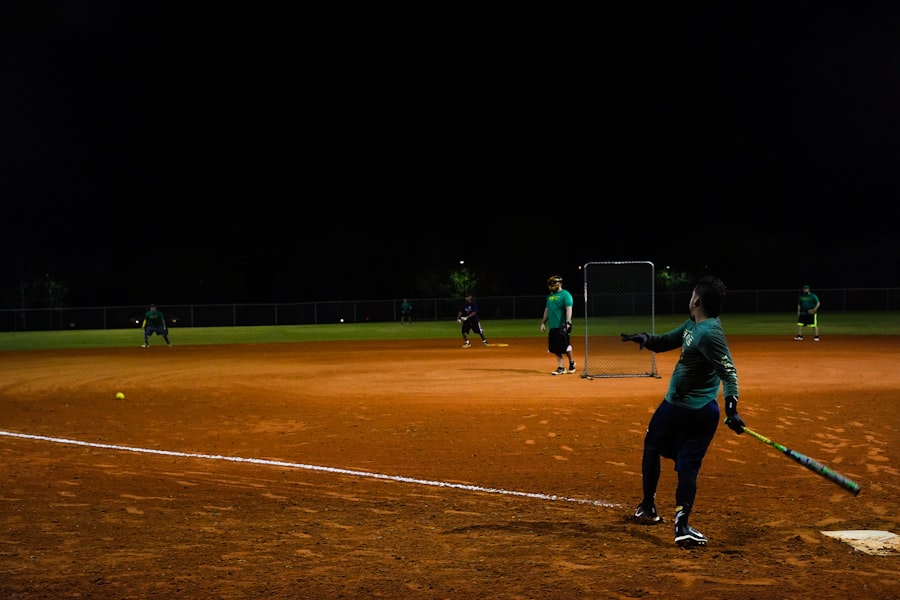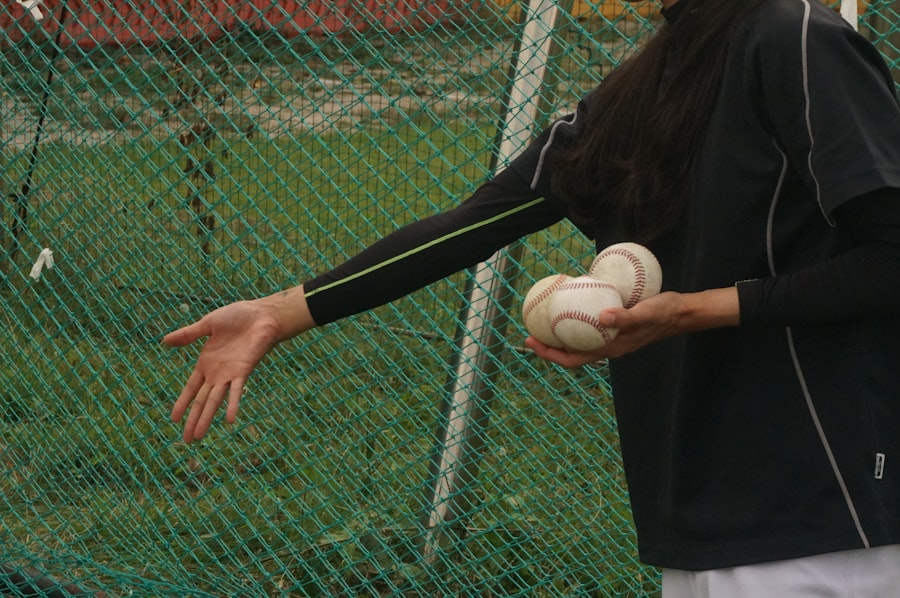Mastering the Art of Softball: Tips for Success
Description
Softball is a dynamic and engaging sport that has captivated players and fans alike since its inception in the late 19th century. It is played on a diamond-shaped field, similar to baseball, but with some key differences that set it apart. The game typically features two teams of nine players each, who take turns batting and fielding.
The objective is to score runs by hitting a pitched ball and successfully reaching a series of bases arranged in a diamond formation. The game can be played in various formats, including fast-pitch and slow-pitch, each with its own set of rules and playing styles. The equipment used in softball is also distinct.
Players utilize a larger ball than that used in baseball, which measures 30.5 centimeters in circumference for women’s fast-pitch and 23 centimeters for slow-pitch. Bats are generally made from aluminum or composite materials, designed to maximize power and control. The field dimensions vary depending on the type of softball being played; for instance, the distance between bases in fast-pitch is typically 60 feet, while the pitching distance is 43 feet for women and 46 feet for men.
Understanding these fundamental aspects of the game is crucial for anyone looking to engage with softball, whether as a player, coach, or spectator.
Key Takeaways
- Softball is a team sport similar to baseball, with a few key differences in rules and equipment.
- Essential skills for success in softball include throwing, catching, hitting, and base running.
- Mastering the fundamentals of hitting involves proper stance, grip, and swing mechanics.
- Improving fielding techniques requires agility, quick reflexes, and proper positioning.
- Enhancing pitching abilities involves mastering different types of pitches and developing accuracy and control.
Developing Essential Skills for Success
To excel in softball, players must cultivate a diverse set of skills that encompass both physical and mental attributes. Fundamental skills such as hitting, fielding, pitching, and base running form the backbone of a player’s ability to contribute effectively to their team. Each skill requires dedicated practice and a commitment to improvement.
For instance, hitting involves not only the mechanics of swinging a bat but also understanding pitch types, timing, and situational awareness. Players must learn to read the pitcher’s movements and anticipate the trajectory of the ball to make solid contact. Fielding is another critical skill that demands agility, coordination, and quick decision-making.
Players must be adept at catching fly balls, fielding grounders, and making accurate throws to bases. This requires not only physical prowess but also an understanding of positioning and strategy. For example, an infielder must know when to charge a ball versus when to play back, depending on the speed of the runner and the type of hit.
Developing these essential skills takes time and repetition; players often engage in drills that focus on specific techniques to enhance their overall performance on the field.
Mastering the Fundamentals of Hitting

Hitting is often regarded as one of the most challenging aspects of softball, requiring a combination of technique, timing, and mental acuity. Mastery begins with understanding the stance and grip on the bat.
The grip should be firm yet relaxed, enabling fluid movement through the hitting zone. Players often experiment with different grips to find what feels most comfortable and effective for them. Timing is another crucial element in hitting.
Players must develop the ability to recognize pitch types—fastballs, curveballs, change-ups—and adjust their swing accordingly. This involves not only visual acuity but also muscle memory developed through countless repetitions in practice. Batting practice often includes drills that simulate game situations, allowing players to refine their timing against live pitching or pitching machines.
Additionally, understanding situational hitting—knowing when to sacrifice for a teammate or when to aim for power—can significantly impact a player’s effectiveness at the plate.
Improving Your Fielding Techniques
| Fielding Techniques | Metrics |
|---|---|
| Catching | Success rate, dropped catches |
| Throwing | Accuracy, arm strength |
| Positioning | First step quickness, reading the ball |
| Communication | Verbal and non-verbal cues, teamwork |
Fielding techniques are essential for any softball player aiming to make significant contributions on defense. The foundation of effective fielding lies in proper footwork and body positioning. Players must learn to approach ground balls with an athletic stance, using their legs to generate power while keeping their glove low to the ground for optimal reach.
Drills that focus on footwork can help players improve their agility and reaction time, allowing them to respond quickly to batted balls. In addition to basic fielding skills, players must also develop advanced techniques such as double plays and cut-offs. Executing a double play requires precise timing and communication between infielders; it’s not just about catching the ball but also about making quick decisions under pressure.
Practicing these advanced techniques in game-like scenarios can help players build confidence and improve their overall defensive capabilities.
Enhancing Your Pitching Abilities
Pitching is often considered the most specialized position in softball, requiring a unique blend of skill, strategy, and mental toughness. A successful pitcher must master various pitch types—such as fastballs, change-ups, curves, and rise balls—to keep batters off balance. Each pitch type has its own mechanics; for instance, throwing a curveball involves imparting spin on the ball while maintaining proper arm motion.
Pitchers often spend hours perfecting their mechanics through drills that focus on grip, release point, and follow-through. Mental preparation is equally important for pitchers. They must develop an understanding of opposing batters’ tendencies and adjust their strategies accordingly.
This involves studying game footage and recognizing patterns in how batters respond to different pitches. Additionally, pitchers need to maintain composure under pressure; they often face high-stakes situations where one pitch can determine the outcome of a game. Building mental resilience through visualization techniques and positive self-talk can help pitchers perform at their best when it matters most.
Building Teamwork and Communication

Softball is inherently a team sport that thrives on collaboration and communication among players. Effective teamwork can significantly enhance a team’s performance on the field. Players must learn to communicate clearly during games—calling for fly balls, signaling plays, or providing encouragement during challenging moments.
Establishing strong lines of communication fosters trust among teammates and ensures that everyone is on the same page during critical plays. Teamwork extends beyond verbal communication; it also involves understanding each player’s strengths and weaknesses. Coaches often emphasize the importance of building chemistry among team members through team-building activities both on and off the field.
This can include group practices focused on specific drills or social events that allow players to bond outside of competitive play. When players feel connected as a unit, they are more likely to support one another during games, leading to improved performance overall.
Mental Preparation and Focus
The mental aspect of softball is just as crucial as physical skills when it comes to achieving success on the field. Players must cultivate mental toughness to handle the pressures of competition effectively. This includes developing focus during games—staying present in each moment rather than dwelling on past mistakes or worrying about future outcomes.
Techniques such as mindfulness meditation can help players enhance their concentration and reduce anxiety. Visualization is another powerful tool used by athletes to prepare mentally for competition. By imagining themselves successfully executing plays or achieving personal goals, players can build confidence in their abilities.
Many elite athletes incorporate visualization into their training routines as a way to mentally rehearse scenarios they may encounter during games. Additionally, setting specific goals—whether they are related to individual performance or team achievements—can provide players with motivation and direction throughout the season.
Advanced Strategies for Competitive Play
As players progress in their softball journey, they often encounter more complex strategies that can give them an edge in competitive play. Understanding game situations is paramount; players must learn how to read opposing teams’ strategies and adapt accordingly. For instance, knowing when to employ a hit-and-run play or when to execute a squeeze bunt can turn the tide of a game in favor of one’s team.
Defensive strategies also play a significant role in competitive softball. Teams may employ shifts based on batter tendencies or adjust their outfield positioning depending on the situation at hand. Coaches often analyze data from previous games to inform these decisions, allowing teams to anticipate opponents’ moves more effectively.
Additionally, developing situational awareness—understanding how many outs there are or what base runners are doing—can help players make smarter decisions during critical moments. In conclusion, mastering softball requires dedication across multiple dimensions—from fundamental skills like hitting and fielding to advanced strategies that enhance competitive play. By focusing on teamwork, mental preparation, and continuous improvement in individual abilities, players can elevate their game and contribute meaningfully to their teams’ success on the field.
If you’re a fan of softball, you may also be interested in learning about the popular mobile game “Plants vs. Zombies 2.” This game combines strategy and action as players defend their homes from a zombie invasion using various plants with unique abilities. Check out this article to find out more about this exciting game.
FAQs
What is softball?
Softball is a bat-and-ball sport that is similar to baseball. It is played on a smaller field and with a larger ball.
How is softball played?
Softball is played between two teams of nine players each. The game consists of innings, with each team taking turns to bat and field.
What are the basic rules of softball?
The basic rules of softball include pitching the ball underhand, hitting the ball with a bat, running the bases, and fielding to get the opposing players out.
What equipment is used in softball?
The equipment used in softball includes a bat, a ball, gloves for fielding, helmets for batting, and protective gear for the catcher.
What are the different types of softball?
There are two main types of softball: fastpitch and slowpitch. Fastpitch softball is played with a larger ball and faster pitching, while slowpitch softball is played with a smaller ball and slower pitching.
What are the health benefits of playing softball?
Playing softball can help improve cardiovascular health, strength, agility, and hand-eye coordination. It also promotes teamwork and social interaction.





